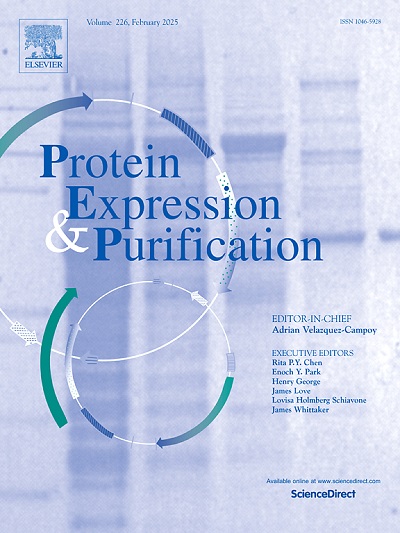Optimized extraction, identification and characterization of the mosquitocidal surface layer protein from a local bacterial isolate Lysinibacillus sphaericus Q001
IF 1.4
4区 生物学
Q4 BIOCHEMICAL RESEARCH METHODS
引用次数: 0
Abstract
Surface layer (S-layer) is an extracellular proteinous layer consisting of two-dimensional lattice. It is typically present on archaea and also found on some bacteria. S-layer proteins from some bacteria are reported to be toxic to mosquito larvae. Here, we aimed to extract and characterize the surface layer protein from a local bacterial strain named Lysinibacillus sphaericus Q001. This bacterium was isolated from Pakistan and characterized through various biochemical tests. It was identified as Lysinibacillus sphaericus through 16S rRNA ribotyping (NCBI accession no. OQ701385.1) and matrix-assisted laser desorption/ionization (MALDI) biotyping with 2.18 ± 0.059 score. The S-layer protein was extracted by both cation exchange method and guanidinium chloride extraction method. The optimized method for the extraction and purification of S-layer yielded 35 mg of protein from 1 L culture of L. sphaericus Q001. A potential S-layer protein band (120 kDa) detected by SDS-PAGE was confirmed by bottom-up proteomics i.e., in-gel tryptic digestion of the protein followed by MALDI-TOF analysis and peptide mass fingerprinting (PMF). The insecticidal bioassays revealed that S-layer protein of L. sphaericus Q001 was toxic against Aedes aegypti larvae with LC50 value of 11 μg/ml. This shows its potential to be used as an alternative to chemical larvicides.
球形赖氨酸芽孢杆菌Q001杀蚊表层蛋白的优化提取、鉴定及特性研究。
表面层(s层)是由二维晶格组成的细胞外蛋白质层。它通常存在于古细菌中,也存在于一些细菌中。据报道,来自某些细菌的s层蛋白对蚊子幼虫有毒。在这里,我们旨在提取并表征当地菌株Lysinibacillus sphaericus Q001的表面层蛋白。这种细菌是从巴基斯坦分离出来的,并通过各种生化试验进行了表征。通过16S rRNA核糖分型(NCBI accession no. 1)鉴定为球形赖氨酸芽胞杆菌。OQ701385.1)和基质辅助激光解吸/电离(MALDI)生物分型,得分为2.18±0.059。采用阳离子交换法和氯化胍萃取法提取s层蛋白。优化后的s层提取纯化方法从1 l球形乳杆菌Q001培养基中提取蛋白35 mg。通过自下而上的蛋白质组学方法,即凝胶胰酶切蛋白,然后进行MALDI-TOF分析和肽质量指纹图谱(PMF),证实了SDS-PAGE检测到的潜在s层蛋白带(120 kDa)。结果表明,L. sphaericus Q001的s层蛋白对埃及伊蚊幼虫具有一定的毒力,LC50值为11 μg/ml。这表明它有可能被用作化学杀幼虫剂的替代品。
本文章由计算机程序翻译,如有差异,请以英文原文为准。
求助全文
约1分钟内获得全文
求助全文
来源期刊

Protein expression and purification
生物-生化研究方法
CiteScore
3.70
自引率
6.20%
发文量
120
审稿时长
32 days
期刊介绍:
Protein Expression and Purification is an international journal providing a forum for the dissemination of new information on protein expression, extraction, purification, characterization, and/or applications using conventional biochemical and/or modern molecular biological approaches and methods, which are of broad interest to the field. The journal does not typically publish repetitive examples of protein expression and purification involving standard, well-established, methods. However, exceptions might include studies on important and/or difficult to express and/or purify proteins and/or studies that include extensive protein characterization, which provide new, previously unpublished information.
 求助内容:
求助内容: 应助结果提醒方式:
应助结果提醒方式:


